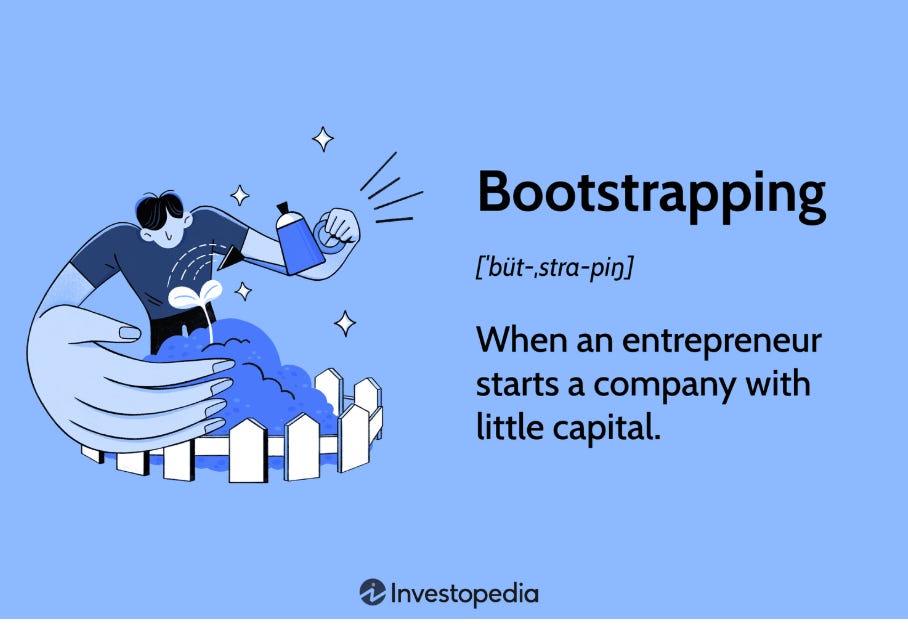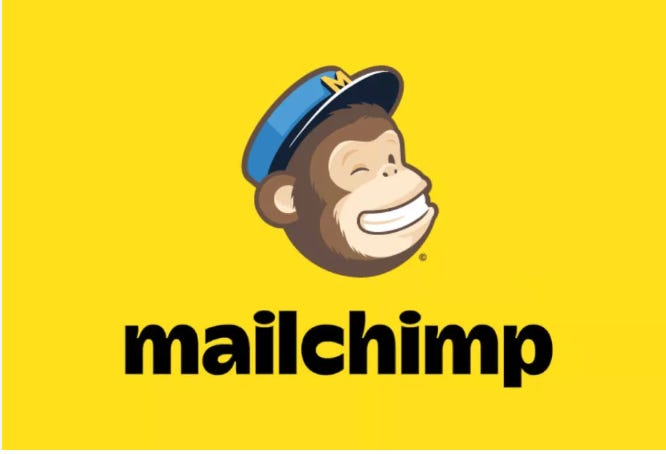Bootstrapped & Thriving: The Scrappy Entrepreneur’s Guide to Starting a Business
Small Business OS: No investors, no problem. Practical steps for how to successfully start and grow a business on a budget.
In 1995, a broke college grad started selling books online from his garage.
Although his budget was tight, his vision was massive.
That scrappy little website, Amazon, became one of the biggest companies in the world. And while not every business will reach Jeff Bezos levels, his story proves that you don’t need deep pockets to build something great. It's all about strategy, and the smartest entrepreneurs always find a way.
They start small, work with what they have, and build something real before ever spending big. They test ideas, get scrappy, and prove their concept without investors or massive upfront costs. That’s bootstrapping in a nutshell: turning limited resources into a thriving business through strategy, creativity, and the most repeated mantra - consistency.
This guide will break down the essentials of bootstrapping so you can hit the ground running, stay on track, and set yourself up for long-term success. We’ve divided the guide into two parts. Part 1 (this one) will lay the foundations for bootstrapping, and Part 2 will share scalable strategies for long-term success, how to reinvest your revenue, the best marketing hacks, and AI prompts.
Let’s go!
Table of Contents: How to Bootstrap a Small Business 101
Start Small: Choosing a Lean Business Model
Popular Bootstrapped Business Models
Bootstrapping in Different Industries
How to Minimize Startup Costs
Funding Your Business Without Investors
Real-Life Examples of Bootstrapped Success
1. Start Small: Choosing a Lean Business Model
When you’re bootstrapping a small business, the last thing you want is to start big with high overhead costs that drain your resources. Instead, adopting a lean business model is crucial, this approach enables you to stretch every dollar and focus on what truly matters: delivering value to your customers. The lean startup approach is all about minimizing waste, testing fast, and iterating as you go. Start small, refine what works, and scale once you have real traction.
The Lean Startup Principles
At the heart of the lean business model is the concept of the Minimum Viable Product (MVP). Rather than spending months or years developing a perfect product, you launch a basic version that addresses your core customer need. This MVP allows you to gather feedback, make improvements, and pivot if necessary, all without investing more than you can afford to lose. It’s a way to test assumptions without betting everything, so you can learn fast and adjust as needed.
Another key principle is iterative development. Instead of aiming for perfection from the get-go, you focus on incremental improvements, continuously tweaking your product based on user feedback. This also means being agile where you adjust your strategy and product offerings as market demands evolve.
2. Popular Bootstrapped Business Models
There are several types of bootstrapped business models that align with the lean principles and are particularly well-suited for entrepreneurs looking to start small:
1. Service-Based Model
Service-based businesses are among the easiest to bootstrap because they generally require less upfront capital compared to product-based businesses. Think consulting, freelance work, or digital services like web design, copywriting, or marketing.
The key here is to leverage your existing skills and network. Start by offering your services to a handful of clients, and as you grow, reinvest profits into expanding your reach or improving your service offerings. This model allows you to test demand without significant overhead and scale at a comfortable pace.
2. Subscription Model
A subscription business model works well for bootstrappers because it provides a predictable, recurring revenue stream. Whether you’re offering digital content, physical goods, or software services, a subscription model allows you to start small and build a loyal customer base over time.
By keeping your initial offerings simple and affordable, you can validate your product without massive upfront investment. Think about platforms like Patreon or subscription box services, these businesses often start with a small audience and grow as they reinvest in enhancing their product or service.
3. Digital Product Model
Digital products, like e-books, online courses, or downloadable software, are perfect for lean businesses because they have very low production costs and can be sold to a global audience. The beauty of digital products is their scalability, you create once and sell repeatedly.
You can start by creating an MVP version of your product and use customer feedback to refine it before scaling. Whether it’s an educational course, a productivity tool, or a niche digital asset, digital products offer high margins with minimal overhead.
4. Freemium Model
A freemium business model involves offering a basic version of your product or service for free, while charging for advanced features or services. This model is great for bootstrappers because it reduces the barrier to entry for customers, allowing you to grow your user base before asking for a sale.
Popular in SaaS (Software as a Service) companies, the freemium model lets you focus on building a large user base quickly, and once you’ve captured their interest, you can monetize through upsells or premium features.
5. Marketplace Model
A marketplace business connects buyers and sellers, facilitating transactions between the two groups. Think of platforms like eBay or Etsy. As a bootstrapped business, you can start by offering a very niche service or product and gradually expand as demand grows.
You don’t need to hold inventory or take on significant upfront costs. Instead, you act as a facilitator and focus on building a robust platform where people can buy and sell, earning revenue from transaction fees or premium listings.
3. Bootstrapping in Different Industries
When you’re bootstrapping a business, the industry you choose can have a significant impact on your strategy, resources, and scalability. Let’s take a look at how bootstrapping plays out in three distinct industries: e-commerce, service-based businesses, and content creation.
E-commerce
E-commerce is one of the most exciting (and challenging) industries to bootstrap. On the one hand, it offers the potential for high margins and massive reach, thanks to the global nature of online shopping. On the other hand, it requires careful management of inventory, logistics, and marketing.
For bootstrapped e-commerce businesses, it’s crucial to start with a lean approach. This could mean focusing on a small, niche product offering rather than trying to launch a large catalog right out of the gate. Consider using a dropshipping model or partnering with suppliers who can handle fulfillment on your behalf. This way, you don’t need to invest in inventory upfront, and you can test demand without tying up capital in unsold products.
Another way to keep costs low is by focusing on organic marketing strategies. Leveraging social media, SEO, and influencer partnerships can help you drive traffic without the need for hefty ad spend. Start small, iterate quickly based on customer feedback, and reinvest profits back into the business to scale.
Service-Based Businesses
Service-based businesses are perfect for bootstrapping. They typically have low startup costs and minimal overhead, making them an ideal choice for entrepreneurs who want to start small and scale sustainably. Whether you’re offering web design, consulting, freelance writing, or digital marketing services, the key to success is building a strong client base and delivering exceptional value.
One of the biggest advantages of service-based businesses is that they allow you to leverage your existing skills. You don’t need to invest heavily in product development or inventory, and often, you can operate with just a laptop and an internet connection. This makes it easy to start with little more than your time and expertise.
To grow your service-based business, focus on building relationships, establishing trust with clients, and developing a strong reputation. Since services often require repeat business, providing great customer service and fostering client loyalty will be crucial for long-term success. As demand grows, you can hire additional help or expand your offerings, all while keeping costs in check and maintaining high margins.
Content Creation
Startup costs in content creation can be incredibly low and how much you can earn as a content creator depends upon creativity, time to build an audience, and how you monetize your work. Whether you’re a blogger, podcaster, YouTuber, or social media influencer, the key is starting small, building an engaged community, and exploring various revenue streams to support your content creation efforts.
For bootstrapped content creators, the most important thing is consistency. Building a loyal following takes time and effort, but once you have an engaged audience, you can start to monetize your content through ad revenue, sponsorships, affiliate marketing, and even direct product sales (like e-books or courses). Start with platforms that offer easy monetization, like YouTube or Patreon, and build a diverse income stream that isn’t reliant on one source. The key is to stay authentic, engage with your audience, and consistently produce valuable content.
4. How to Minimize Startup Costs
When you’re bootstrapping a business, keeping costs low is absolutely essential. Every dollar saved is a dollar that can be reinvested to grow your business, and there are plenty of ways to minimize expenses without sacrificing quality.
Here are some practical strategies to help you get your business off the ground without breaking the bank.
💰 Use Free or Affordable Tools
One of the best ways to keep costs down when bootstrapping is by using free or low-cost tools that are widely available. Instead of splurging on expensive software and resources, take advantage of the many free and affordable options that can help you run your business efficiently.
For example, you can start with free versions of project management tools like Trello or Asana to keep your tasks organized. For website development, platforms like WordPress or Wix offer free plans to help you build a professional-looking site without hiring a developer. For email marketing, use tools like Mailchimp or Sendinblue that allow you to send emails to small lists at no charge. Social media management platforms like Hootsuite and Buffer offer free versions that allow you to schedule posts and manage multiple accounts.
As your business grows and your needs become more complex, you can begin to upgrade to paid tools, but starting with free options lets you minimize early expenses while maintaining productivity.
💰 Work from Home
If you’re launching a service-based business, one of the biggest ways to reduce costs is by working from home. The expense of renting office space can quickly drain your resources, especially when you’re just starting. By keeping your operations within the comfort of your own home, you can save on rent, utilities, office equipment, and commuting costs.
Working from home also gives you the flexibility to set your own hours and save time, allowing you to focus more on growing your business rather than dealing with logistics. Plus, many clients are increasingly open to remote work and virtual meetings, so it’s easier than ever to operate from anywhere.
If you do need to meet with clients in person, consider using co-working spaces on an as-needed basis, which offer affordable and flexible memberships. They can provide you with a professional environment without the long-term commitment or high costs of a traditional office.
💰 DIY Marketing
When you’re bootstrapping, your marketing budget is likely limited. But that doesn’t mean you can’t create a strong marketing presence. In fact, many successful bootstrappers start with DIY marketing tactics that don’t require a significant investment.
One of the best DIY marketing strategies is social media. Platforms like Instagram, Facebook, LinkedIn, and Twitter are all free to use, and you can engage with your audience directly by posting valuable content, sharing your story, and participating in relevant conversations. You don’t need to be a social media expert to create a community, just be authentic, consistent, and responsive to your followers.
Content marketing is another highly effective, low-cost strategy. Start a blog on your website and post regular content that addresses your target audience’s pain points. Over time, quality blog posts will help improve your search engine rankings and attract organic traffic, all without spending a dime on ads. You can also leverage email marketing by building an email list and sending out newsletters or promotional offers to keep customers engaged and encourage repeat business.
Word-of-mouth marketing can be extremely powerful when you are just starting out. Encourage satisfied customers to leave reviews and refer their friends. If you’re offering great service, your clients will be your best marketers.
4. Funding Your Business Without Investors
Securing funding for your business can often feel daunting, especially if you’re looking to avoid traditional investors. Fortunately, there are several alternative funding methods that can help you get your business off the ground without giving up equity or taking on significant debt. Let’s explore a few practical, investor-free funding options to help you turn your business dreams into reality.
Personal Savings
One of the most straightforward and often the first option for bootstrappers is to dip into your own savings. This might be from a personal savings account, retirement fund, or even a rainy-day stash you’ve set aside. The advantage of using personal savings is that you don’t have to worry about repaying a loan or giving up equity.
However, this option does carry personal risk, as you’re investing your own money into the business. It’s important to only use savings you’re willing and able to lose, and make sure you keep a safety net for personal expenses. While it may be tempting to pour everything into your business, maintaining financial stability for yourself and your family should always be a priority.
Revenue Reinvestment
A powerful way to fund your venture is to reinvest the profits your business generates. Instead of paying yourself a large salary or spending your revenue on unnecessary expenses, funnel it back into the business to fuel growth. This approach allows you to grow your company organically, using your own earnings to fund operations, marketing, and expansion.
Revenue reinvestment helps you avoid the pressure of external debt or outside investors. It also ensures that you remain in complete control of your business. The key here is to start small, keep overhead low, and be mindful of cash flow. As your profits increase, so will your ability to reinvest and scale the business without relying on external funding.
Microloans and Grants
Microloans and grants can be a great way to quickly raise funds without giving up equity or taking on high-interest debt. Microloans are typically small loans provided by non-profit organizations or community development financial institutions (CDFIs). These loans often come with favorable terms, and they can be used to cover expenses like equipment, inventory, or working capital.
A grant, on the other hand, is essentially free money that doesn’t need to be repaid. Grants are often offered by government agencies, non-profits, and private organizations. While grants can be highly competitive, they can provide a financial cushion as you grow your business. Both microloans and grants tend to be more accessible to businesses that focus on social impact, innovation, or underrepresented industries, so be sure to research options available for your specific business type.
Pre-Sales
Another great way to fund your business without investors is through pre-sales. This approach is especially useful for product-based businesses, particularly those launching new items or creating prototypes. Essentially, pre-sales involve selling your product before it’s actually produced or shipped. Customers pay upfront for the product, providing you with the necessary funds to manufacture or fulfill their orders.
Pre-sales not only give you the capital you need but also serve as a form of market validation. If people are willing to pay for your product before it even exists, that’s a clear indication that there’s demand for it. Plus, pre-sales help minimize financial risk by allowing you to gauge interest before committing to large production runs.
5. Real-Life Examples of Bootstrapped Success
Bootstrapping may seem like a difficult path to success, but there are many inspiring stories of businesses that started with nothing but a great idea, a small amount of capital, and a lot of determination. These companies prove that it’s possible to build something extraordinary without external funding.
Here are three remarkable examples of bootstrapped success:
Mailchimp: Built Entirely from Customer Revenue
Mailchimp, the popular email marketing platform, is a prime example of bootstrapping done right. Founded by Ben Chestnut and Dan Kurzius in 2001, Mailchimp was built entirely from the revenue generated by its customers—there was no outside investment or venture capital funding. The company grew steadily over the years by reinvesting its profits into expanding services and improving user experience.
Mailchimp's success story is a great example of the power of focusing on customer satisfaction and maintaining control over the business. By prioritizing user needs, continually iterating on their product, and growing at a sustainable pace, Mailchimp became a multi-billion-dollar company without ever taking on outside funding.
Spanx: From $5,000 to a Billion-Dollar Brand
Sara Blakely’s journey from selling fax machines to becoming a billionaire with Spanx is one of the most famous bootstrapped success stories. With just $5,000 in savings, Blakely created a revolutionary line of shapewear that would go on to change the fashion industry. Her relentless persistence and dedication to her vision led her to build Spanx from the ground up, without any outside investors or loans.
Blakely's story is a reminder that sometimes all you need is an idea that solves a problem, combined with the courage to take risks and the perseverance to keep going. Spanx is now a globally recognized brand, and Sara Blakely's success as a self-made billionaire has inspired countless entrepreneurs to start their own bootstrapped businesses.
Patagonia: Gradual Growth from Small Savings
Patagonia, the outdoor clothing brand, is another iconic example of bootstrapping success. Founder Yvon Chouinard started the company in 1973 with a small investment and a passion for creating high-quality outdoor gear. Chouinard's focus on environmental sustainability and ethical business practices, combined with a commitment to quality, helped the brand gradually grow over the years.
Patagonia’s growth was fueled by steady reinvestment of profits rather than relying on external capital. Today, Patagonia is not only a successful business but also a global leader in environmentally conscious business practices. The company’s commitment to both its mission and its customers helped it scale without sacrificing its core values, proving that slow and steady growth can lead to long-term success.
That’s a wrap for today, stay tuned for Part 2 next week!







Didn’t Amazon have deep pockets with a $300,000 investment from his parents?
I enjoyed reading this . I will link it somewhere in my publications!